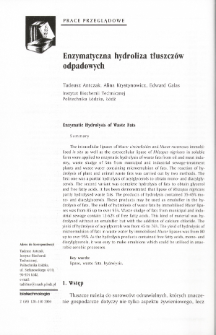- Search in all Repository
- Literature and maps
- Archeology
- Mills database
- Natural sciences
Advanced search
Advanced search
Advanced search
Advanced search
Advanced search

Object
Title: Enzymatic Hydrolysis of Waste Fats
Subtitle:
Enzymatic Hydrolysis of Waste Fats
Publisher:
Committee on Biotechnology PAS ; Institute of Bioorganic Chemistry PAS
Abstract:
The intracellular lipases of Mucor circinelloides and Mucor racemosus immobilised in situ as well as the extracellular lipase of Rhizopus nigricans in solubleform were applied to enzymatic hydrolysis ofwaste fats from oil and meat industry, waste sludge of fats from municipal and industrial sewage-treatmentplants and waste water containing microemulsion of fats. The reaction of hydrolysis of plant and animal waste fats was carried out by two methods. Thefirst one was a partial hydrolysis of acylglycerols to obtain mono- and diacylglycerols. The second variant was complete hydrolysis of fats to obtain glyceroland free fatty acids. It has been demonstrated that lipase of Rhizopus nigricanspartly hydrolysed waste fats. The products of hydrolysis contained 35-45% mono- and diacylglycerols. These products may be used as emulsifier in the hydrolysis of fats. The yield of hydrolysis of waste fats by immobilised Mucor lipases was from 85 up to over 95%. Waste sludge of fats from municipal and industrial sewage contain 12-62% of free fatty acids. This kind of material was hydrolysed without an emulsifier but with the addition of calcium chloride. Theyield of hydrolysis of acylglycerols was from 45 to 76%. Tne yield of hydrolysis ofmicroemulsion of fats in waste water by immobilised Mucor lipases was from 80up to over 95%. As the hydrolysis products contained free fatty acids, mono- anddiacylglycerols, it was easy to make emulsions which could be utilised in anaerobic-aerobic processes.
Relation:
Biotechnologia, vol.49, 2 (2000)-.
Volume:
Issue:
Start page:
End page:
Detailed Resource Type:
Format:
Resource Identifier:
0860-7796 ; oai:rcin.org.pl:141525 ; IChB B-45
Source:
Library of Institute of Bioorganic Chemistry PAS
Language:
Language of abstract:
Temporal coverage:
Rights:
Creative Commons Attribution BY-SA 4.0 license
Terms of use:
Digitizing institution:
Institute of Bioorganic Chemistry of the Polish Academy of Science
Original in:
Institute of Bioorganic Chemistry of the Polish Academy of Science
Projects co-financed by:
Access:
Object collections:
- Digital Repository of Scientific Institutes > Partners' collections > Institute of Bioorganic Chemistry PAS > Articles
- Digital Repository of Scientific Institutes > Literature > Journals/Articles
Last modified:
Oct 12, 2020
In our library since:
Oct 5, 2020
Number of object content downloads / hits:
1009
All available object's versions:
https://rcin.org.pl./publication/176828
Show description in RDF format:
Show description in RDFa format:
Show description in OAI-PMH format:
| Edition name | Date |
|---|---|
| Enzymatyczna hydroliza tłuszczów odpadowych | Oct 12, 2020 |
Objects Similar
Antczak, Tadeusz Krystynowicz, Alina Galas, Edward
Antczak, Tadeusz Krystynowicz, Alina Hiler, Danuta Bielecki, Stanisław Galas, Edward
Galas, Edward Kwapisz, Ewa Tarabasz-Szymańska, Łucja Krystynowicz, Alina Antczak, Tadeusz Oryńska, Agnieszka
Antczak, Tadeusz Galas, Edward
Antczak, Tadeusz Galas, Edward
Antczak, Tadeusz Hiler, Dariusz Galas, Edward
Krystynowicz, Alina Turkiewicz, Marianna Dryńska, Elżbieta Galas, Edward
Antczak, Tadeusz Bugla, Joanna Szeja, Wiesław Galas, Edward

 INSTYTUT ARCHEOLOGII I ETNOLOGII POLSKIEJ AKADEMII NAUK
INSTYTUT ARCHEOLOGII I ETNOLOGII POLSKIEJ AKADEMII NAUK
 INSTYTUT BADAŃ LITERACKICH POLSKIEJ AKADEMII NAUK
INSTYTUT BADAŃ LITERACKICH POLSKIEJ AKADEMII NAUK
 INSTYTUT BADAWCZY LEŚNICTWA
INSTYTUT BADAWCZY LEŚNICTWA
 INSTYTUT BIOLOGII DOŚWIADCZALNEJ IM. MARCELEGO NENCKIEGO POLSKIEJ AKADEMII NAUK
INSTYTUT BIOLOGII DOŚWIADCZALNEJ IM. MARCELEGO NENCKIEGO POLSKIEJ AKADEMII NAUK
 INSTYTUT BIOLOGII SSAKÓW POLSKIEJ AKADEMII NAUK
INSTYTUT BIOLOGII SSAKÓW POLSKIEJ AKADEMII NAUK
 INSTYTUT CHEMII FIZYCZNEJ PAN
INSTYTUT CHEMII FIZYCZNEJ PAN
 INSTYTUT CHEMII ORGANICZNEJ PAN
INSTYTUT CHEMII ORGANICZNEJ PAN
 INSTYTUT FILOZOFII I SOCJOLOGII PAN
INSTYTUT FILOZOFII I SOCJOLOGII PAN
 INSTYTUT GEOGRAFII I PRZESTRZENNEGO ZAGOSPODAROWANIA PAN
INSTYTUT GEOGRAFII I PRZESTRZENNEGO ZAGOSPODAROWANIA PAN
 INSTYTUT HISTORII im. TADEUSZA MANTEUFFLA POLSKIEJ AKADEMII NAUK
INSTYTUT HISTORII im. TADEUSZA MANTEUFFLA POLSKIEJ AKADEMII NAUK
 INSTYTUT JĘZYKA POLSKIEGO POLSKIEJ AKADEMII NAUK
INSTYTUT JĘZYKA POLSKIEGO POLSKIEJ AKADEMII NAUK
 INSTYTUT MATEMATYCZNY PAN
INSTYTUT MATEMATYCZNY PAN
 INSTYTUT MEDYCYNY DOŚWIADCZALNEJ I KLINICZNEJ IM.MIROSŁAWA MOSSAKOWSKIEGO POLSKIEJ AKADEMII NAUK
INSTYTUT MEDYCYNY DOŚWIADCZALNEJ I KLINICZNEJ IM.MIROSŁAWA MOSSAKOWSKIEGO POLSKIEJ AKADEMII NAUK
 INSTYTUT PODSTAWOWYCH PROBLEMÓW TECHNIKI PAN
INSTYTUT PODSTAWOWYCH PROBLEMÓW TECHNIKI PAN
 INSTYTUT SLAWISTYKI PAN
INSTYTUT SLAWISTYKI PAN
 SIEĆ BADAWCZA ŁUKASIEWICZ - INSTYTUT TECHNOLOGII MATERIAŁÓW ELEKTRONICZNYCH
SIEĆ BADAWCZA ŁUKASIEWICZ - INSTYTUT TECHNOLOGII MATERIAŁÓW ELEKTRONICZNYCH
 MUZEUM I INSTYTUT ZOOLOGII POLSKIEJ AKADEMII NAUK
MUZEUM I INSTYTUT ZOOLOGII POLSKIEJ AKADEMII NAUK
 INSTYTUT BADAŃ SYSTEMOWYCH PAN
INSTYTUT BADAŃ SYSTEMOWYCH PAN
 INSTYTUT BOTANIKI IM. WŁADYSŁAWA SZAFERA POLSKIEJ AKADEMII NAUK
INSTYTUT BOTANIKI IM. WŁADYSŁAWA SZAFERA POLSKIEJ AKADEMII NAUK




































